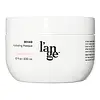What's inside
What's inside
 Key Ingredients
Key Ingredients

 Benefits
Benefits

 Concerns
Concerns

 Ingredients Side-by-side
Ingredients Side-by-side

Water
Skin ConditioningGlycerin
HumectantCetyl Alcohol
EmollientStearyl Alcohol
EmollientCetyl Palmitate
EmollientBehentrimonium Chloride
PreservativeAmodimethicone
Cetrimonium Chloride
AntimicrobialDimethicone
EmollientKeratin
Skin ConditioningBorago Officinalis Seed Oil
EmollientPanthenol
Skin ConditioningTocopheryl Acetate
AntioxidantLinum Usitatissimum Seed Oil
PerfumingParfum
MaskingIsopropyl Alcohol
SolventPhenoxyethanol
PreservativeCitric Acid
BufferingMagnesium Nitrate
Magnesium Chloride
Acetic Acid
BufferingTrideceth-12
EmulsifyingSodium PCA
HumectantMethylchloroisothiazolinone
PreservativeMethylisothiazolinone
PreservativeHydrolyzed Keratin
HumectantWater, Glycerin, Cetyl Alcohol, Stearyl Alcohol, Cetyl Palmitate, Behentrimonium Chloride, Amodimethicone, Cetrimonium Chloride, Dimethicone, Keratin, Borago Officinalis Seed Oil, Panthenol, Tocopheryl Acetate, Linum Usitatissimum Seed Oil, Parfum, Isopropyl Alcohol, Phenoxyethanol, Citric Acid, Magnesium Nitrate, Magnesium Chloride, Acetic Acid, Trideceth-12, Sodium PCA, Methylchloroisothiazolinone, Methylisothiazolinone, Hydrolyzed Keratin
Water
Skin ConditioningCetyl Alcohol
EmollientStearyl Alcohol
EmollientSorbitol
HumectantDimethicone
EmollientParfum
MaskingParaffinum Liquidum
EmollientC11-13 Isoparaffin
SolventIsohexadecane
EmollientKeratin
Skin ConditioningCeramide AP
Skin ConditioningPropylene Glycol
HumectantDiazolidinyl Urea
PreservativeIodopropynyl Butylcarbamate
PreservativeBehentrimonium Chloride
PreservativeCitric Acid
BufferingIngredients Explained
These ingredients are found in both products.
Ingredients higher up in an ingredient list are typically present in a larger amount.
This ingredient is a preservative and often used for it's anti-static properties. You'll most likely see this ingredient in hair conditioners.
It does not cause irritation or sensitization in leave-on products at 1-5%.
Cetyl Alcohol is a fatty alcohol. Fatty Alcohols are most often used as an emollient or to thicken a product.
Its main roles are:
Though it has "alcohol" in the name, it is not related to denatured alcohol or ethyl alcohol.
The FDA allows products labeled "alcohol-free" to have fatty alcohols.
Learn more about Cetyl AlcoholCitric Acid is an alpha hydroxy acid (AHA) naturally found in citrus fruits like oranges, lemons, and limes.
Like other AHAs, citric acid can exfoliate skin by breaking down the bonds that hold dead skin cells together. This helps reveal smoother and brighter skin underneath.
However, this exfoliating effect only happens at high concentrations (20%) which can be hard to find in cosmetic products.
Due to this, citric acid is usually included in small amounts as a pH adjuster. This helps keep products slightly more acidic and compatible with skin's natural pH.
In skincare formulas, citric acid can:
While it can provide some skin benefits, research shows lactic acid and glycolic acid are generally more effective and less irritating exfoliants.
Most citric acid used in skincare today is made by fermenting sugars (usually from molasses). This synthetic version is identical to the natural citrus form but easier to stabilize and use in formulations.
Read more about some other popular AHA's here:
Learn more about Citric AcidDimethicone is a type of synthetic silicone created from natural materials such as quartz.
What it does:
Dimethicone comes in different viscosities:
Depending on the viscosity, dimethicone has different properties.
Ingredients lists don't always show which type is used, so we recommend reaching out to the brand if you have questions about the viscosity.
This ingredient is unlikely to cause irritation because it does not get absorbed into skin. However, people with silicone allergies should be careful about using this ingredient.
Note: Dimethicone may contribute to pilling. This is because it is not oil or water soluble, so pilling may occur when layered with products. When mixed with heavy oils in a formula, the outcome is also quite greasy.
Learn more about DimethiconeKeratin is a protein naturally found in our hair and skin.
In haircare, it has been shown to seal broken cuticles. This can help prevent breakage and split ends.
Parfum is a catch-all term for an ingredient or more that is used to give a scent to products.
Also called "fragrance", this ingredient can be a blend of hundreds of chemicals or plant oils. This means every product with "fragrance" or "parfum" in the ingredients list is a different mixture.
For instance, Habanolide is a proprietary trade name for a specific aroma chemical. When used as a fragrance ingredient in cosmetics, most aroma chemicals fall under the broad labeling category of “FRAGRANCE” or “PARFUM” according to EU and US regulations.
The term 'parfum' or 'fragrance' is not regulated in many countries. In many cases, it is up to the brand to define this term.
For instance, many brands choose to label themselves as "fragrance-free" because they are not using synthetic fragrances. However, their products may still contain ingredients such as essential oils that are considered a fragrance by INCI standards.
One example is Calendula flower extract. Calendula is an essential oil that still imparts a scent or 'fragrance'.
Depending on the blend, the ingredients in the mixture can cause allergies and sensitivities on the skin. Some ingredients that are known EU allergens include linalool and citronellol.
Parfum can also be used to mask or cover an unpleasant scent.
The bottom line is: not all fragrances/parfum/ingredients are created equally. If you are worried about fragrances, we recommend taking a closer look at an ingredient. And of course, we always recommend speaking with a professional.
Learn more about ParfumStearyl Alcohol is a type of fatty alcohol from stearic acid. It is a white, waxy compound used to emulsify ingredients.
Fatty Alcohols are most often used as an emollient or to thicken a product. Emollients help soothe and hydrate the skin by trapping moisture.
They are usually derived from natural fats and oils and therefore do not have the same drying or irritating effect as solvent alcohols. FDA allows products labeled "alcohol-free" to have fatty alcohols.
Learn more about Stearyl AlcoholWater. It's the most common cosmetic ingredient of all. You'll usually see it at the top of ingredient lists, meaning that it makes up the largest part of the product.
So why is it so popular? Water most often acts as a solvent - this means that it helps dissolve other ingredients into the formulation.
You'll also recognize water as that liquid we all need to stay alive. If you see this, drink a glass of water. Stay hydrated!
Learn more about Water